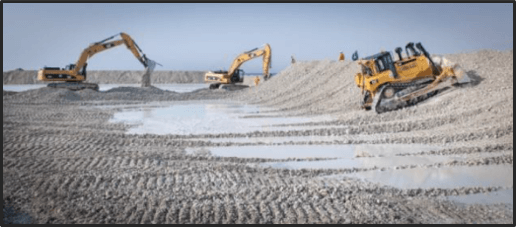Salt Harvesting
The goal of the salt harvesting project is to create a permanent solution for the problem of rising water level in Pond 5 and to stabilize the level by harvesting the salt and transferring it to the northern basin of the Dead Sea.
The minerals from the Dead Sea are extracted by way of solar evaporation, whereby salt precipitates onto the bed of the salt ponds, the first evaporation ponds of ICL Dead Sea. The salt pond known as Pond 5 is the first and largest pond in the series of ponds, having an area of approximately 80 square kilometers. The evaporation processes give rise to concentration of the brines and the sinking of the salt to the floor of the pond. The remaining brines are rich in potash, magnesium and bromide. Approximately 20 million tonnes of salt precipitate at the bottom of pond 5 each year, creating a 20 cm layer of salt annually. The layers of salt are accumulated one on top of the other. The precipitation of salt reduces the amount of brine in the pond. The production process of the raw material requires that a fixed brine volume is maintained in the Pond. To this end, the pond level is raised each year according to the rate at which its floor rises.
However, the rise of water level in Pond 5 above a certain level may cause structural damage to the foundations of the hotel structures situated close to the water’s edge and to other infrastructures on the western shoreline of Pond 5. Therefore, it was decided to initiate a project to protect the hotels’ beaches and infrastructure. The project is managed, for the past few years, by the Dead Sea Preservation Government Company. As part of the coastline defenses project, dikes and other infrastructures were raised at the western beach of the pond, the area near the hotels. The project is now at its final stages. The coastline defenses are meant to provide protection until the completion of the permanent solution (the salt harvest), which is a sustainable solution that will provide protection.
ICL will bear 80% of the cost of the Salt Harvest and the government will bear 20% of the cost.

In April 2017, after receiving all the permits for execution of the Salt Harvesting agreement, ICL’s Board of Directors approved a budget of about $280 million to further proceed with the execution of the Salt Harvesting. This budget, will be spent over the next 12 years and constitutes ICL’s share (80%) in the cost of performing this part. In October 2017, DSW signed an agreement, for execution of the first stage of the Salt Harvesting Project, with Holland Shallow Seas Dredging Ltd., a contracting company, to commence construction of a special dredger that is designed to execute the salt harvesting. The dredger is expected to enter into service during 2019.
ICL’s Board of Directors approved a budget of about $280 million to further proceed with the execution of the Salt Harvesting in the Dead Sea.
For more information about the coastline defenses and the permanent solution, see “Item 4 – Information on the Company— D. Property, Plant and Equipment— Mineral Extraction and Mining Operations” and “Concessions and Mining Rights” in ICL 2018 Annual Report.
